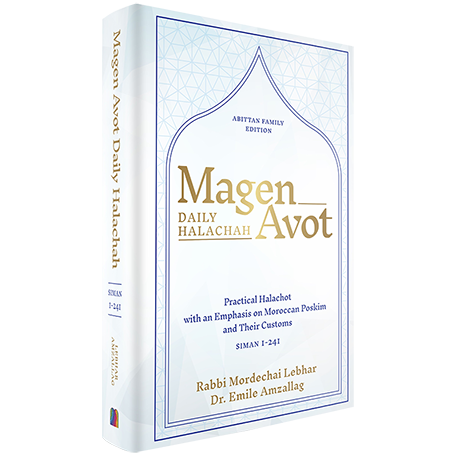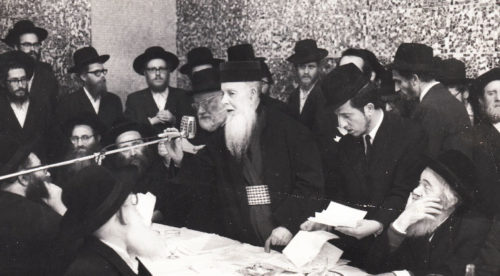Halachot in the tradition of our Chachamim from Morocco
Dozens of Audio & Video Shiurim by Rabbi Mordechai Lebhar
Hilula of Moroccan Tzadikim
Sefarim based on our Morrocan Minhagim
Monthly Sponsor: Available
Weekly Sponsor: Available
Sponsor of the Day: Available

Magen Avot - Daily Halacha
Click here to purchase
Daily Moroccan Halachot
Rabbi Mordechai Lebhar, author Magen Avot
Redacted by Dr. Emile Amzallag
DAILY HALACHOT PODCAST  ON APPLE
ON APPLE  ON SPOTIFY
ON SPOTIFY
Daily Halachot Topics
The Shulchan Aruch (Orah Haim 142:1) explains that if one makes a mistake, even involving only one letter, while reading the Torah, he must repeat the word correctly. The Rama (ibid.) modifies this approach by saying that the reader need be corrected only if his mistake changed the meaning or context of the word. Furthermore, the Rama states that a mistake in the cantillation (“Te’amim”) or in punctuation (“Nikud”) is not grounds for correcting the one reading the Torah, however, he should be reprimanded. According to Rabbi Avraham Buchach (Eshel Avraham), the the Rama’s intention of “reprimanded” means that the reader should be told in a gentle manner of his mistakes after the Torah reading so that he may correct them in the future. Certainly, publicly reprimanding the reader in a harsh tone is forbidden. Although not grounds for correcting the reader at the time of the Torah reading, the Zohar gives tremendous importance to the proper singing of the cantillation, and the Bet Yosef explains that even on a practical level, they are useful in setting the rhythm and pauses in each verse. Rabbi Shlomo Zalman Auerbach (Halichot Shlomo, ch.18 § 24) gives practical guidelines as to what does and does not require a reader to be corrected at the time of the Torah reading: a) Confounding Mil’el and Milra’ (placing emphasis on the penultimate, versus the final syllable of a word, respectively); b) repeating a word; c) Confounding Shva Na and Shva Nach (when the Shva is pronounced like an “e” vowel, versus not being pronounced at all, respectively) are example of errors which need not be corrected. On the other hand, mistakes in emphatic cantillation notes such as Shalshelet, or even Sof Pasuk, which have contextual significance, should be corrected at the time of the reading. Interestingly, the Brisker Rav (Shu”t Teshuvot VeHanhagot, vol. 5 § 37) was particular that one should hear the Torah being read according to one’s tradition. Nevertheless, the overwhelming consensus is that one fulfills one’s obligation to hear the Torah in any rite, be it Ashkenazic, Sephardic, etc. Summary: Certain errors, which do not change the meaning or ontext of a word or verse, do not need to be corrected when the Torah is being read. It is written (Masechet Sofrim 14:1) that the pious people of Jerusalem had the practice of showing great honor to the Torah when it was being brought out to be read. Similarly, the Rama writes (Orah Haim 149:1) that it is a Mitzvah to accompany the Torah when it is being brought from the Hechal to the Teva, or vice versa, as a sign of respect. Furthermore, the Maharil applies the concept of “Berov Am Hadrat Melech” to accompanying the Torah, meaning that the greater the multitude of people involved in a Mitzvah, the more the Torah, and by extension, Hashem, is glorified. The Mitzvah of accompanying and walking behind the Torah is incumbent on those before whom the Torah passes. Those who are further away, however, do not have accompany it, although it is praiseworthy to do so. Additionally, Rabbi Avraham Azoulay (Sefer HaLevush 149:1) says that there is a Mitzvah to kiss the Sefer Torah. He learns this from an a fortiori (“Kal Vahomer”) logic; just as one is obligated to kiss one’s Tefillin, which only contains portions of the Torah, one is certainly obligated to kiss the entire Torah. This is also written by the Arizal (Sha’ar HaKavanot, pg. 48), who was known to kiss the Torah itself, not simply by touching it and then kissing his hand. Furthermore, Rabbi Eliezer Waldenberg (Tzitz Eliezer vol. 12, § 40) disapproves of the practice of bringing the Torah towards people, or lowering it for children, so that they may kiss it, as this does not show honor to the Torah. Rather, people should themselves go towards the Torah to kiss it. Rabbi Benzion Mutzafi (Orhot Zion, pg. 315) says that the Torah may be lowered slightly for someone who is wheelchair-bound for example, in order to touch or kiss the Torah. Summary: There are several forms of honor accorded to the Sefer Torah such as accompanying it or kissing it. The Tur (Orah Haim 149) explains that there are two customs with regards to returning the Sefer Torah to the Hechal on a weekday. One custom, as followed by many Ashkenzim, is that once the reading is completed, Kaddish is recited by the Hazan, the Sefer Torah is returned to the Hechal, and then “Uva Letzion” is recited. The Arizal supports this custom because he posits that once the reading of the Torah is completed, the spiritual lights that emanate from it are extinguished and the Torah should therefore be returned immediately. The second opinion given by the Tur, which was the custom in Spain, is to return the Torah after the reciting “Uva Letzion”. This latter custom is further subdivided into two practices, with some Sepharadim reciting Kaddish Titkabal after the Torah is returned to the Hechal, and others, based on the Avudraham and the Kolbo, reciting Kaddish Titkabal while the Torah is still out. Furthermore, the Shulhan Aruch (Orah Haim 25:13) writes that the custom is to avoid removing one’s Tefilin while the Torah is still out. The Mishna Berura (ibid:57) says that this is alluded to in the verse (Micha 2:13) “Vaya’avor Malkam Lifnehem V’Hashem BeRosham” (lit. “and their king passed before them, and Hashem was at their head”), with the Tefilin Shel Rosh being symbolic of Hashem. The ideal state of a Jewish man is to be crowned with the Tefilin, and therefore if one must remove one’s Tefilin while the Torah is still out, it is proper to do so while the scroll is covered up so as not to reveal one’s bare head. Nevertheless, the Ben Ish Hai (Od Yosef Hai, Parashat Haye Sara, § 2) says that this only applies to those scrolls that are covered in a velvet cover, commonly used by Ashkenazim and Moroccans. One, however would be permitted to remove one’s Tefillin beside a Torah that is placed in a hard case since the scroll is permanently covered. Summary: One should not remove one’s Tefilin while the Torah still out. If one must do so, one should wait until the scroll is covered. The Gemara (Berachot 4b) relates that whoever recites Tehila LeDavid (Mizmor 145) thrice daily is guaranteed a place in the World to Come. Accordingly, the Sages incorporated this psalm three times during the day; during Pesuke DeZimra, before Uva Letzion and prior to the Minha Amida. Some have the custom to recite the verse “Yehi Hasdecha Hashem Alenu Ka’asher Yihalnu Lach” before the psalm, however, according to the Livorno rite (upon which many Moroccan customs are based), this verse only is said before Tehila LeDavid of Shabbat Musaf. The Avudraham explains that the mere fact of reciting the Mizmor three times is not what guarantees the World to Come, but rather saying it intently. Therefore, by saying it three times daily, it assures that it will be said intently at least once. Furthermore, the Bet Yosef explains that Tehila LeDavid itself does not necessarily guarantee Olam Haba, but rather that if one’s merits and one’s sins are equal, reciting the Mizmor intently can tip the proverbial scale in one’s favor. The Shibole Haleket says that the verses of “Hanun VeRahum” and “Karov Hashem” allude to the word “Hok”, which has an implication of permanence and also has the same numerical value as “Gehinom”. This alludes to the fact that one who recites the Tehila LeDavid three times daily will not inherit the judgement of Gehinom. Summary: It is praiseworthy to recite Tehila LeDavid three times daily. On weekday mornings, the Ashre preceding Uva Letzion is followed by Mizmor 20 (“Ya’ancha Hashem”). According to the Zohar HaHadash (Parashat Balak), this psalm has nine verses, which correspond to the nine months leading up to the final redemption during which the Mashiah will take suffering upon himself. Furthermore, there are seventy words, corresponding to the seventy ministers of each nation of the world, whom the Mashiah will vanquish. Rabbi Meir ben Gabai (Tola’at Yaakov, Sod Nefilat Apaim) writes that the nine verses and seventy words correlate with the nine months of pregnancy and the seventy cries a woman makes during contractions, respectively. Interestingly, he writes that a woman will not give birth until she has articulated seventy cries during her labor contractions. As well, the Mizmor has three hundred and ten letters, which correspond to the amount of spiritual worlds that Hashem created. This psalm was incorporated into the prayer because, as the Avudraham explains, it begins and ends with the words “Ya’ancha” and “Ya’anenu”, which convey the idea of Hashem answering our prayers. The universal Sephardic custom is that Tahanun and Mizmor 20 are linked, such that on any day that Tahanun is omitted, this psalm is omitted as well. Conversely, the Rama writes (Orah Haim 131:1) that the Ashkenazic custom is that there are some days when Tahanun is omitted but the Mizmor is still recited, such when a groom is present. Summary: Mizmor 20 has deep significance. The Sephardic custom is that on any weekday morning on which Tahanun is omitted, Mizmor 20 is omitted as well. It is auspicious to recite this psalm when a woman is in labor. After the Ashre and Mizmor 20, “Uva Letzion” and the special Kedusha that accompanies it (known as “Kedusha D’Sidra”) are recited. Several reasons are given as to why our Sages included it in the weekday morning prayers. The Avudraham explains that it was intended for those unlearned people who would arrive late to the synagogue to be able to recite Kedusha, which they missed during the repetition of the Amida. The Levush (O.H. 132) writes that Uva Letzion was enacted because at the time, it was decreed by the non-Jewish authorities that sanctifying Hashem through Kedusha was forbidden. As such, it was placed after the Amida, at which point the authorities believed the prayer was already completed. Furthermore, the Kedusha is accompanied by an Aramaic translation and one reason was so that the aforementioned unlearned congregants would be able to understand what was being said, as Aramaic was the vernacular of the masses at the time. The Arizal explains that it is also recited in Aramaic so as to conceal the full extent of its holiness, which may be too much to bear. As well, Rabbi Moshe Zachuta says that since the angels’ function is to sanctify Hashem, they may become jealous, as it were, when we say Kedusha and thus it is recited in a language they do not comprehend. The Rama (Orah Haim 132:1) explains that the Kedusha D’Sidra has the same status as the Kedusha recited in the blessings of Keriat Shema, and as such it may be recited by an individual without a Minyan. The HIDA (Kesher Gudal) concurs, and Rabbi Shalom Messas explains that this was also the custom in Morocco. Summary: Uva Letzion and Kedusha D’Sidra hold deep significance and they may be recited without a Minyan. The last paragraph of the Kedusha D’Sidra begins “Baruch Elokenu Shebera’anu Lichvodo”. The Arizal explains that since this segment thanks Hashem for giving us life and for distinguishing us from the other nations of the world and all types of falsehood, it should be said with intense concentration. Rabbi Eliezer Papo (Hesed LaAlafim 131:19) says that when one recites the words “Lo Niga Larik” (lit. “may we not toil in vain”) and “Lo Neled LaBehala” (lit. “may we not give birth to futility”), one should have in mind to pray to not have wasted seed as this may lead to unviable children. Regarding these words, Rabbi Israel Algazi (Shalme Tzibur) says that when reciting them, one should focus on having children who will grow to be righteous Torah scholars. Furthermore, when reciting “Baruch Elokenu Shebera’anu Lichvodo”, one should imagine oneself being thrown into a fire rather than succumb to a life of falsehood. Summary: The last paragraph of Kedusha D’Sidra should be said with intent concentration. After Uva Letzion, Mizmor 86 (“Tefila LeDavid”) and the verses of Bet Ya’akov arerecited. The Seder Hayom, the Avudraham and the Tur all discuss Mizmor 86 and say that it was instituted because in it, we ask Hashem to answer all our prayers. Additionally, they mention that one should be careful to recite it and to not treat it lightly. Rabbi Haim Palagi (Kaf HaHaim Palagi 17:14) notes that the psalm has 186 words, which equals the numerical value of “Makom”, or Hashem’s omnipresence, and thus one should have great concentration during its recital. Furthermore, the sum of the products of the value of each letter in Hashem’s four-letter Name, Yud-Ke-Vav-Ke(10×10+5×5+6×6+5×5), is also 186. Interestingly, according to the Sephardic custom, on days that Tahanun is omitted,Tefila LeDavid is also omitted. Rabbi Simha Rabinowitz (Piske Teshuvot § 132) explains this by saying that the psalm says “Beyom Tzrati Ekraeka” (lit. “on the day of my distress I shall call You”), which refers to days on which Tahanun is said. According to Nusach Sfard, there are days when Tahanun is not recited but Tefila LeDavid isrecited, such as when a groom is present. Summary: One should recite Mizmor 86 with intent concentration. It is notrecited on days that Tahanun is omitted. On each day of the week in the times of the Bet HaMikdash, the Levi’im would recite a psalm corresponding to that day. To commemorate this, a different Mizmor is recited on each day of the week during the Shaharit prayer, known as the Shir Shel Yom. Before each Mizmor, an introductory phrase is recited: “Hashir Shehayu Halvi’im Omrim Al Haduchan Beyom [day of the week] BeShabbat” (lit. “the psalm that the Levites would recite on the platform on the [day of the week] from the Sabbath”). The reason the psalm for a particular day is prefaced with that sentence can be explained as follows: The Mechilta d’Rabbi Yishmael (Parashat Yitro, Parasha 7) says that one way of fulfilling the commandment to remember the Sabbath by doing things in anticipation of Shabbat, such as preparing a delicious dish for the Shabbat meal. The Ramban (Shemot 20:7), basing himself on the Mechilta, explains that remembering and thinking about Shabbat is a constant Mitzvah. As such, the Arizal (Sha’ar HaKavanot 60a) that when one prefaces the daily psalm by counting the day of the week relative to Shabbat, one is fulfilling the commandment to constantly remember Shabbat. Rabbi Yosef Hazan (Shu”t Hikre Lev, vol. 2, Orah Haim, § 32) that this introduction is a significant custom and that when reciting it, one should have in mind that one is fulfilling the commandment of “Zachor Et Yom HaShabbat Lekadesho”, to sanctify the Sabbath by remembering it. Summary: One should have in mind that, by reciting the introductory sentence before each Shir Shel Yom, one is fulfilling the commandment to remember Shabbat. In general, when Rosh Hodesh, Hanukkah, a public fast, etc. fall on a weekday, the Sephardic custom is to recite the Mizmor designated for that day in addition to Bet Ya’akov, Shir Hama’alot, Shir Shel Yom and Hoshienu. There is a lesser known custom among Sepharadim, including Moroccans, however, to omit Bet Ya’akov, Shir Hama’alot, Shir Shel Yom and Hoshienu and to only recite the special Mizmor. One may ask why the Shir Shel Yom as well as the Mizmor for the special day are not both recited. The HIDA (Birkei Yosef 693:3) quotes the Yerushalmi (Shekalim and Sukkah), which says that once one Mizmor is recited it abrogates the other one. Rabbi Yosef Hazan (Shu”t Hikre Lev, vol. 2, Orah Haim, § 32) explains at length that in the times of the Bet HaMikdash, the Levi’im would sing the Shir Shel Yom, unless there was another occasion such as Rosh Hodesh, in which case the Mizmor for that day would be sung. Furthermore, he says that the nowadays, we do not recite the Shir Shel Yom to emulate exactly what was done in the Bet HaMikdash, but rather to highlight the specialness of each day of the week. Therefore, if another special day takes place, the Mizmor specific to that day is recited and there is no reason to add on the Shir Shel Yom. As such, Rabbi Yedidya Monsonego (Pirhe Shoshanim, Hilchot Tefila § 14), Rabbi David Ovadia (Nahagu Ha’am, Hilchot Tefila § 25), Rabbi Raphael Ben Shimon (Nahar Mitzrayim, Hilchot Tefila § 11) and Rabbi David HaKohen-Skali (Kiryat Hana David, vol. 2, § 20) write that the custom in Morocco and Egypt was to omit the Shir Shel Yom when the day coincided with a Rosh Hodesh, Hanukkah, a public fast, Purim or if a groom was present, and to recite the Mizmor specific to that day only. There were communities in Morocco that included the Shir Shel Yom, Bet Ya’akov, etc., but they were in the minority. Summary: The Shir Shel Yom, along with Bet Ya’akov, Shir Hama’alot and Hoshienu are omitted on Rosh Hodesh, Hanukkah, Purim, a Ta’anit or when a groom is present, and only the Mizmor specific for that day is recited. Te’amim and Pronunciation
Honoring the Sefer Torah
Returning the Torah
Tehila LeDavid
Mizmor of “Ya’ancha Hashem”
Uva Letzion
What’s the Significance of “Baruch Elokenu”?
What’s the Significance of “Tefila LeDavid”?
Why is the Day of the Week Mentioned Before Shir Shel Yom?
Shir Shel Yom on Special Days
Sign up for the Daily Moroccan Halachot Email


